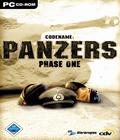Buy 'CODENAME: Panzers Phase One': PC
Scootch together, children, whilst Grandpa Mark tells you what it was like to wargame when he was your age. Back in the day, we didn’t have no fancy computers to play our games on, no-siree-bob; we had Avalon Hill board games with counters, lots of little cardboard counters. It took us two hours to set the damn game up, and ten hours to play the fool thing, not counting the inevitable arguments over Line of Sight. We didn’t need to worry about walking uphill in the snow both ways to play our games; we were housebound nerds who had about as much use for the outdoors as an Eskimo does Bermuda shorts.
That changed in the mid-'90s when a truly excellent series debuted on my lowly 486: Close Combat by Atomic Games. This game came the closest to mimicking the feel of classics like Avalon Hills’s Squad Leader, although truth be told, I still missed fishing counters out of the vacuum cleaner and fighting with my friend over the rules, but I digress. That series went the way of horse-drawn artillery, leaving the RTS genre hopelessly mired in a sea of games requiring you to build bases and churn out fighting lemmings; victory went to he who could build crap the fastest.
Now comes Codename: Panzers. Full disclosure: I did the preview for this title, and I’m quoted on the inside flap of the retail box saying, “honest-to-goodness strategy.” I felt that way during the preview and playing the retail build hasn’t changed my mind one bit. Panzers dispenses with the need to build a base and units, instead forcing you to get through the level using the units you start with. To me, it makes for a more challenging game, as I usually learn where I made mistakes and what I need to do the next time. The problem with this, though, is it tends to lend itself to a certain amount of “try the level a few times to find out where the tank is hiding.” But I’ll forgive it for that.
There are three campaigns in Panzers: the German, which has you leading the charge through Poland; the Russian, who are leading the charge through the other side of Poland; and the Allies, who are charging through France. The game even features a scantily clad female, who, I assume, is charging her credit cards through Frederick’s of Hollywood. Aside: just what is she doing in this game? I’m usually not opposed to a little gratuitous T&A, but why mar such an excellent game with a foolish boob shot?
I’m going to spend the next 1500 words or so talking up the game’s good and bad points, but I’ll cut to the chase and let you get going if you want with this simple summarization: this is one fun little beer-and-pretzels strategy game that doesn’t take itself, or the genre, too seriously.
Most real-time-strategy games I’ve played inevitably end up frustrating me, usually because I couldn’t mass-produce faster than the AI, or the pathfinding is hideously bad, or the AI in general has the intelligence of a brainless baboon. Panzers was frustration-free. No bases meant no assembly-line unit production; the pathfinding, while still having some minor issues, at least got out of its own way; and the AI wasn’t half-bad.
The 30 missions in the three campaigns are nicely varied, forcing you to take key points, defend points, and protect convoys. Each mission will also have optional secondary objectives that are actually worth completing. Once you finish a mission you earn Prestige Points, which allow you to buy reinforcements for the next mission, so finishing the secondary objectives earns you more points, making later missions a tad easier since you can purchase more units.
The units themselves are balanced and fairly realistic. There’s no rock-paper-scissors theory at work here, each tank has an armor rating that must be defeated before it starts taking actual damage. Your tanks will be untouched by infantry — unless of course, they are equipped with anti-tank weapons — as the armor on the tanks is impervious to small arms fire. However, the overall effectiveness of the tanks is underpowered in Panzers, as their range and overall damage is lowered. Tanks that would normally be able to fire to the other side of the map and destroy a target in one shot will barely be able to clear the fog of war and will take multiple hits to destroy it. It’s one of the rare moments the game succumbs to an arcade feel, and, again, it’s forgiven for it.
As you continue through the missions, inevitably your army will become vehicle-centric, as they are simply that much more effective. The infantry, while weak, do have their uses. For one, they can take over abandoned units like tanks and artillery pieces, as well as garrison themselves in buildings.
You also have several off-map support devices like carpet-bombing, fighter bombing and reconnaissance. They are quite effective and help turn the tide of battle.
The joy of the game, though, is combining the different forces into a successful attack. While the missions are linear, they encourage creativity and there’s no “right” way to complete the mission. By allowing flexibility with both how you complete the mission and choosing the makeup of your forces, the game does an excellent job at allowing you to play it the way you want to, and not the way some developer thinks you should.
The game is very easy to play and uses the standard RTS key commands — if you’ve played any RTS before, you’ll be right at home here. There are a few subtle things I appreciated, though, like visual clues across the top of the screen when you assign units to a group. The objectives are clearly marked, both on the map and in the mission objective. A welcome treat is the ability to save the game whenever you want.
The AI is decent, as RTS games go, though, it won’t dazzle you with its brilliance, and it at least doesn’t act totally ignorantly. I noticed units trying to get a better angle, forcing an attack, and running away. What I did wish was that the enemy also had the same off-map support options that I did; it would have made for a nice variety if it also bombed me. I also felt that the game was appropriately challenging; it left me wanting to replay a failed mission to get through it, but it didn’t make me want to hurl the CDs into the dumpster.
The unit pathfinding does the job as well, where units are smart enough to get out of each other’s way, but it’s not smart enough to get out of the way of an incoming attack. The tanks also move realistically, backing up to turn around instead of spinning on a dime.
There’s also a slight role-playing element in Panzers, as each campaign takes place through the eyes of one of that nation’s officers. Each mission starts with an entry to his journal and then a cut scene. You’ll also need to keep this unit alive, but that’s not as problematic as in other games; he can actually take a few hits and is usually in a tank.
There are over 50 different types of units you can use, with a mixture of tanks, artillery, self-propelled artillery, medics, snipers, flamethrowers, etc. Also, you can choose some add-ons like binoculars to extend your infantry’s range and rafts to help get across the water. There are a few concessions they’ve made to realism in the interests of aiding game play: you can also purchase repair and ammo vehicles to service your tanks during the mission. Just move a tank near either of these two vehicles and they’ll automatically be repaired and topped off.
Graphically the game is impressive and really shows off what the Gephardt engine can do. Things blow up beautifully, tanks leave tracks and can run over hedges, power poles and fences and some buildings can be blown up. The only real downer is the cut scenes, while the characters look decent, there’s no lip movement and the scenes as a whole are forgettable.
Sound-wise the game is a mixed bag. The explosions and sound effects are well done, but the voice acting gets a little rough.
In addition to the single-player campaign there are skirmish and multiplayer modes that allow you to use a predetermined amount of points to build up an army.
Overall, Panzers is one of the best RTS games I’ve played in the last ten years, although I’ll put in the disclaimer that I really, really hate base building. I also enjoy its attempts to be mostly historically accurate. While some of the large battles are represented, I wish my role in them wasn’t a bit part. However, if you’re as much of a fan of old-school wargaming as I am, you’ll thoroughly enjoy Codename Panzers: Phase One. I can’t wait to see what Phase Two has in store for us.
Score: 8.4/10
More articles about Codename: Panzers - Phase One











 Panzers takes you into the heady battles of World War II. Whether you play in towns with bullet-riddled buildings, bleak mountain landscapes or treacherous swamps - Panzers gives you real-time combat rampages in awesome 3D graphics. Experience the nerve-jangling thrill of strategic gaming - in Panzers!
Panzers takes you into the heady battles of World War II. Whether you play in towns with bullet-riddled buildings, bleak mountain landscapes or treacherous swamps - Panzers gives you real-time combat rampages in awesome 3D graphics. Experience the nerve-jangling thrill of strategic gaming - in Panzers!










































